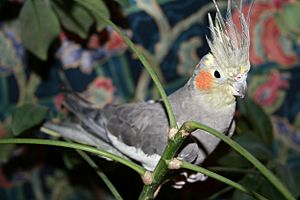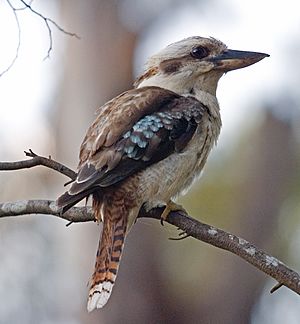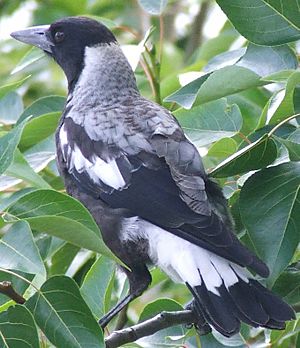Birds of Australia facts for kids


Australia is a special place for birds! As of 2014, there were 898 different kinds of birds recorded here. Many of these birds, about 45%, are endemic to Australia. This means you can only find them naturally in Australia and nowhere else on Earth.
Some birds are also called vagrants. These are birds that usually live somewhere else but visit Australia by accident. Sadly, scientists think that about 10% of Australia's bird species might disappear by the year 2100 because of climate change.
Australian birds come in all sizes. The smallest is the weebill, which is only about 8 centimeters long. The biggest is the emu, a huge bird that cannot fly.
You might see some Australian birds that look a lot like birds from other parts of the world. For example, Australian wrens look and act like wrens from the Northern Hemisphere. Australian robins also seem similar to European robins.
However, these birds are not actually close relatives. Most Australian songbirds (called passerines) are related to the crow family. The reason they look similar is something called convergent evolution. This means different animals develop similar features because they live in similar environments and have similar lifestyles.
For example, a small bird that hunts insects needs to be quick and agile. It might have long legs for running and short wings for fast, short flights. Birds in different parts of the world can develop these same features even if they are not related.
Here are some Australian birds that look like birds from other places:
- Honeyeaters look like sunbirds.
- Sittellas look like nuthatches.
- Australasian babblers look like scimitar babblers.
- Australian robins look like Old World chats.
- Scrub robins look like thrushes.
Contents
Types of Australian Birds
Scientists group Australian birds into six main types. This helps us understand where they came from and how they live.
Old Endemics
These birds have lived in Australia for a very long time. They are not songbirds. Many of them are linked to an ancient supercontinent called Gondwana. Good examples are the huge, flightless emus and cassowaries. The large group of parrots also belongs here.
Corvid Radiation Birds
These are songbirds (passerines) that are unique to Australia and nearby islands. They all descended from the crow family. Over time, they have changed and now fill many different roles and sizes. Some examples include wrens, robins, magpies, thornbills, pardalotes, and the big honeyeater family. You can also find treecreepers, lyrebirds, birds-of-paradise, and bowerbirds in this group.
Eurasian Colonists
These birds arrived in Australia later from Eurasia (Europe and Asia). They include birds like plovers, swallows, larks, thrushes, cisticolas, sunbirds, and some raptors (birds of prey).
Recently Introduced Birds
These are birds that humans brought to Australia more recently. Some, like the European goldfinch and greenfinch, seem to live alongside native birds without causing problems. However, others, like the common starling, blackbird, house and tree sparrows, and the common myna, can harm native bird populations.
Migratory Shorebirds
This group includes many waders. These birds breed in northern Asia and Alaska. They then fly all the way to Australia and nearby islands to spend their non-breeding season.
Seabirds

This is a large group of birds that live mostly at sea. They include petrels, albatrosses, sulids (like gannets and boobies), gulls, terns, and cormorants. Many of them breed on islands that are part of Australia or spend a lot of time near Australia's coasts and waters.
Bird Organizations in Australia
Many groups work to protect and study birds in Australia.
National Organizations
- BirdLife Australia is a very important group. It helps protect birds and their homes. It also supports people who watch and study birds.
- The Australian Bird Study Association is for people who band birds (put small tags on their legs to track them) and study birds in the wild.
Regional and State Organizations
There are also many bird groups in different parts of Australia:
- In the Australian Capital Territory, you can find the Canberra Ornithologists Group.
- New South Wales has groups like Birding NSW.
- Queensland has Birds Queensland.
- South Australia has Birds SA.
- Tasmania has Birds Tasmania.
- Victoria has Birds Australia - Victoria.
- Western Australia has Birds Australia Western Australia.

Images for kids



















